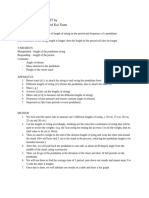0 ratings0% found this document useful (0 votes)
68 viewsTime Taken For 10 Oscillation: 1A10 4 June 2010
Time Taken For 10 Oscillation: 1A10 4 June 2010
Uploaded by
Nor AishahThis document describes an experiment to study the relationship between the length of a pendulum and the time taken for it to complete 10 oscillations. The hypothesis is that as the length of the pendulum string increases, the time taken for oscillation will also increase. Various pendulum lengths from 10cm to 50cm were tested, and the results showed that longer pendulums did take more time to complete 10 oscillations, supporting the hypothesis.
Copyright:
Attribution Non-Commercial (BY-NC)
Available Formats
Download as PPTX, PDF, TXT or read online from Scribd
Time Taken For 10 Oscillation: 1A10 4 June 2010
Time Taken For 10 Oscillation: 1A10 4 June 2010
Uploaded by
Nor Aishah0 ratings0% found this document useful (0 votes)
68 views10 pagesThis document describes an experiment to study the relationship between the length of a pendulum and the time taken for it to complete 10 oscillations. The hypothesis is that as the length of the pendulum string increases, the time taken for oscillation will also increase. Various pendulum lengths from 10cm to 50cm were tested, and the results showed that longer pendulums did take more time to complete 10 oscillations, supporting the hypothesis.
Original Description:
this experiments will help you in section B
Original Title
Experiment'
Copyright
© Attribution Non-Commercial (BY-NC)
Available Formats
PPTX, PDF, TXT or read online from Scribd
Share this document
Did you find this document useful?
Is this content inappropriate?
This document describes an experiment to study the relationship between the length of a pendulum and the time taken for it to complete 10 oscillations. The hypothesis is that as the length of the pendulum string increases, the time taken for oscillation will also increase. Various pendulum lengths from 10cm to 50cm were tested, and the results showed that longer pendulums did take more time to complete 10 oscillations, supporting the hypothesis.
Copyright:
Attribution Non-Commercial (BY-NC)
Available Formats
Download as PPTX, PDF, TXT or read online from Scribd
Download as pptx, pdf, or txt
0 ratings0% found this document useful (0 votes)
68 views10 pagesTime Taken For 10 Oscillation: 1A10 4 June 2010
Time Taken For 10 Oscillation: 1A10 4 June 2010
Uploaded by
Nor AishahThis document describes an experiment to study the relationship between the length of a pendulum and the time taken for it to complete 10 oscillations. The hypothesis is that as the length of the pendulum string increases, the time taken for oscillation will also increase. Various pendulum lengths from 10cm to 50cm were tested, and the results showed that longer pendulums did take more time to complete 10 oscillations, supporting the hypothesis.
Copyright:
Attribution Non-Commercial (BY-NC)
Available Formats
Download as PPTX, PDF, TXT or read online from Scribd
Download as pptx, pdf, or txt
You are on page 1of 10
Time Taken For
10 Oscillation
NOR AISHAH BT NORRIFIN
1A10
4 June 2010
Aim
To study the relationship between the
length of the pendulum and the time
taken for the simple pendulum to
oscillate
Statement of the Problem
How is the oscillation time of the
pendulum influenced by the length of the
pendulum.
Hypothesis
As the length of the string increases, the
time taken for the pendulum oscillation
becomes longer.
Materials and Apparatus
Pendulum
String
Retort stand
Retort clamp
Stop watch
Variable
what you measured - time taken for 10
oscillation
Measurements – length of change
pendulum
Kept constant – mass of
pendulum bob
Procedure
a) Hang 10 cm long pendulum onto the clamp of a
retort stand.
b) Pull the pendulum bob to one side, then release.
Record the time taken for 10 oscillation in the
table. Repeat this step three times.
c) Repeat the experiment for pendulum lengths of 20
cm, 30cm, 40,cm and 50cm.
Recording Of Data
Pendulum Time for 10 pendulum oscillations (s)
length (cm) Experiment Experiment 2 Experiment Average
1 3
10 6.0 5.8 6.2 6.0
20 9.6 9.8 9.7 9.7
30 13.1 13.0 13.1 13.0
40 16.2 16.4 16.0 16.2
50 18.5 18.6 18.2 18.4
Conclusion
As the length of the pendulum increases,
the time of the pendulum oscillation
increases. The hypothesis form can
be accepted.
Discussion
1. The recording of the results is carried out three
times in order to get a more exact and accurate
average reading.
2. In using a simple pendulum, we must bear in mind
a few points if the results is to be accurate.
- the support must be rigid so that it does not
shake when the pendulum is oscillating.
- the point of support should the string firmly.
- the timing should be repeated a few times and
the average time taken.
- the swing must be in vertical plane and not in
an ellipse. The angle of oscillation must also
be small.
You might also like
- Tutorial 5 Equilibrium AnswerDocument4 pagesTutorial 5 Equilibrium AnswerNor AishahNo ratings yet
- Experiment Apparatus Used: Theory:: Coefficient of Damping (B)Document2 pagesExperiment Apparatus Used: Theory:: Coefficient of Damping (B)amitNo ratings yet
- Experiment 3 (Simple Pendulum)Document3 pagesExperiment 3 (Simple Pendulum)arjun singhNo ratings yet
- Topic AIM Statement of Problem Hypothesis Variables: StringDocument1 pageTopic AIM Statement of Problem Hypothesis Variables: Stringlembu_sihat77No ratings yet
- Physics Lab #4 Conical PendulumDocument6 pagesPhysics Lab #4 Conical PendulumOraine RNo ratings yet
- Takwin Physics ProjectDocument15 pagesTakwin Physics Projectitsjustmy6emailNo ratings yet
- L4 The Simple PendulumDocument13 pagesL4 The Simple PendulumNur Syamiza ZamriNo ratings yet
- Lab Report 3Document5 pagesLab Report 3LaibaNo ratings yet
- Physics Lab ReportDocument4 pagesPhysics Lab Reportakanakia1No ratings yet
- Paperclip Pendulum AiDocument5 pagesPaperclip Pendulum Aiamritmaharaj543No ratings yet
- PendulumDocument17 pagesPendulumBaoz PingNo ratings yet
- Physics Lab ReportDocument6 pagesPhysics Lab ReportTotako MatsuNo ratings yet
- Mass of Stopper Lab PREAP PhysicsDocument5 pagesMass of Stopper Lab PREAP PhysicsgongsterrNo ratings yet
- Force and Motion - Circular Motion Activity SheetDocument4 pagesForce and Motion - Circular Motion Activity SheetALEJANDRO CORTEZNo ratings yet
- Local Acceleration Due To Gravity Using Simple PendulumDocument9 pagesLocal Acceleration Due To Gravity Using Simple PendulumAshu t100% (3)
- Objective: The TheoryDocument7 pagesObjective: The TheoryNeha BhartiNo ratings yet
- Simple Harmonic Motion LabDocument12 pagesSimple Harmonic Motion LabDaniel JamesNo ratings yet
- Physics LAB Report Simple PendulumDocument7 pagesPhysics LAB Report Simple PendulumDoom Doo100% (1)
- Takwin Physics ProjectDocument11 pagesTakwin Physics Projectitsjustmy6emailNo ratings yet
- تجربة 1Document2 pagesتجربة 1m26292391No ratings yet
- The Investigation of Simple PendulumDocument6 pagesThe Investigation of Simple PendulumUgne KupryteNo ratings yet
- Year 10 Physics - MotionDocument18 pagesYear 10 Physics - MotionKevin XiaoNo ratings yet
- Pendulum Experiment (Fiver Work)Document3 pagesPendulum Experiment (Fiver Work)Shayan FarrukhNo ratings yet
- Pendulum Experiment: Trial Length of String (Centimeters) Time (Seconds)Document3 pagesPendulum Experiment: Trial Length of String (Centimeters) Time (Seconds)Shayan FarrukhNo ratings yet
- Measurements of Length, Mass, Density, and TimeDocument5 pagesMeasurements of Length, Mass, Density, and Timeanwar9602020No ratings yet
- Simple Pendulum.Document13 pagesSimple Pendulum.ab594100% (5)
- Pendulum WorksheetDocument2 pagesPendulum Worksheetdr lailaNo ratings yet
- SCIENCE FORM 1 Experiment 1.1 PendulumDocument1 pageSCIENCE FORM 1 Experiment 1.1 PendulumnisaNo ratings yet
- Force and Motion - Circular Motion Activity Sheet - 2Document3 pagesForce and Motion - Circular Motion Activity Sheet - 2saintEmNo ratings yet
- مختبر الفيزياء الطبية - pendulumDocument6 pagesمختبر الفيزياء الطبية - pendulumm9ngmnsxp4No ratings yet
- Form 1 Science Pendulum ExperimentDocument2 pagesForm 1 Science Pendulum ExperimentAngie Kong Su Mei0% (1)
- QualityGroup7 Project1 Taguchi AnalysisDocument10 pagesQualityGroup7 Project1 Taguchi AnalysisCaleb HoNo ratings yet
- Simple Harmonic MotionDocument6 pagesSimple Harmonic MotionnorllizaNo ratings yet
- Yoyo 9.1 Lab Report On Hooke S Law 1Document7 pagesYoyo 9.1 Lab Report On Hooke S Law 1Linda LiNo ratings yet
- Centripetal AccelerationDocument2 pagesCentripetal AccelerationDaniel ByrneNo ratings yet
- The Time Period of A Simple Pendulum Remains Constant For A Particular Length. Verify It.Document13 pagesThe Time Period of A Simple Pendulum Remains Constant For A Particular Length. Verify It.diyaNo ratings yet
- Using A Pendulum Practical Write Up: Nikhil NaikDocument6 pagesUsing A Pendulum Practical Write Up: Nikhil NaikBen HeilerNo ratings yet
- Pick Out Information You Deem To Be Necessary From The Excerpt BelowDocument3 pagesPick Out Information You Deem To Be Necessary From The Excerpt Belowcrampersad100No ratings yet
- Grade 10 Physics LabsDocument25 pagesGrade 10 Physics Labsjamaulallen2020No ratings yet
- PendulumDocument4 pagesPendulumKale'ab LemmaNo ratings yet
- Physics Laboratory Report Determining The Acceleration Due To Gravity Using A PendulumDocument3 pagesPhysics Laboratory Report Determining The Acceleration Due To Gravity Using A PendulumAlexNo ratings yet
- Uniform Circular MotionDocument14 pagesUniform Circular MotionKenneth NyuNo ratings yet
- Answer The FollowingDocument5 pagesAnswer The FollowingFalak SetaNo ratings yet
- HSC Phy Pendulum PracDocument11 pagesHSC Phy Pendulum PracBen Kierse0% (2)
- Cambridge Kinematics EssayDocument12 pagesCambridge Kinematics EssaySuresh SenanayakeNo ratings yet
- 1.1.2.1 Pendulum Practical ActivityDocument2 pages1.1.2.1 Pendulum Practical Activityphantomlc69No ratings yet
- Using A Pendulum Practical Write UpDocument6 pagesUsing A Pendulum Practical Write Upشەیدایانی قورئانNo ratings yet
- Science Chapter 1, Form 1...... Experiment of PendulumDocument5 pagesScience Chapter 1, Form 1...... Experiment of PendulumKasthuriNo ratings yet
- Centripetal Force LabDocument8 pagesCentripetal Force LabGrant BrownNo ratings yet
- Lab 5 VibrationsDocument9 pagesLab 5 Vibrationsbilalraza8654No ratings yet
- Pendulum Lab ReportDocument7 pagesPendulum Lab ReportD ViNo ratings yet
- Lab Report 1 & 2Document10 pagesLab Report 1 & 219MME-S1-323 Usman Ul Hassan PirzadaNo ratings yet
- (Laporan Amali 1 (2 Skor)Document2 pages(Laporan Amali 1 (2 Skor)Norazian Binti TaatNo ratings yet
- Lab 6 - Simple PendulumDocument5 pagesLab 6 - Simple Pendulumsamueldeegan0130No ratings yet
- Exp - Rept (PN - Halimah)Document3 pagesExp - Rept (PN - Halimah)Rosnani GhazaliNo ratings yet
- Simple Pendulum Rev 09102019Document2 pagesSimple Pendulum Rev 09102019Maria KaramathNo ratings yet
- Science Form1 Chapter 1Document41 pagesScience Form1 Chapter 1Che Norasiykin89% (9)
- G6 - Arpil Intake Lab Report 4Document12 pagesG6 - Arpil Intake Lab Report 4Rohan JeremiahNo ratings yet
- Enhanced Oil Recovery: Resonance Macro- and Micro-Mechanics of Petroleum ReservoirsFrom EverandEnhanced Oil Recovery: Resonance Macro- and Micro-Mechanics of Petroleum ReservoirsRating: 5 out of 5 stars5/5 (1)
- 1 - Introducing YourselfDocument9 pages1 - Introducing YourselfNor AishahNo ratings yet
- ESSAYS - An Incident That I Cannot ForgetDocument1 pageESSAYS - An Incident That I Cannot ForgetNor AishahNo ratings yet
- Poems - I Wonder (Form 1)Document1 pagePoems - I Wonder (Form 1)Nor AishahNo ratings yet
- ESSAYS - An Incident That I Cannot ForgetDocument1 pageESSAYS - An Incident That I Cannot ForgetNor AishahNo ratings yet
- Smart Note Chapter 3Document7 pagesSmart Note Chapter 3Nor AishahNo ratings yet
- Air Pollution: Nur Aizat Nur Aishah Chin Lit Ming Nur Farahin Chan Zhing YieDocument7 pagesAir Pollution: Nur Aizat Nur Aishah Chin Lit Ming Nur Farahin Chan Zhing YieNor AishahNo ratings yet

































































